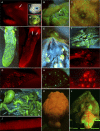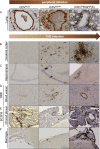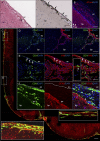Recombinant canine distemper virus strain Snyder Hill expressing green or red fluorescent proteins causes meningoencephalitis in the ferret
- PMID: 22553334
- PMCID: PMC3416283
- DOI: 10.1128/JVI.06725-11
Recombinant canine distemper virus strain Snyder Hill expressing green or red fluorescent proteins causes meningoencephalitis in the ferret
Abstract
The propensity of canine distemper virus (CDV) to spread to the central nervous system is one of the primary features of distemper. Therefore, we developed a reverse genetics system based on the neurovirulent Snyder Hill (SH) strain of CDV (CDV(SH)) and show that this virus rapidly circumvents the blood-brain and blood-cerebrospinal fluid (CSF) barriers to spread into the subarachnoid space to induce dramatic viral meningoencephalitis. The use of recombinant CDV(SH) (rCDV(SH)) expressing enhanced green fluorescent protein (EGFP) or red fluorescent protein (dTomato) facilitated the sensitive pathological assessment of routes of virus spread in vivo. Infection of ferrets with these viruses led to the full spectrum of clinical signs typically associated with distemper in dogs during a rapid, fatal disease course of approximately 2 weeks. Comparison with the ferret-adapted CDV(5804P) and the prototypic wild-type CDV(R252) showed that hematogenous infection of the choroid plexus is not a significant route of virus spread into the CSF. Instead, viral spread into the subarachnoid space in rCDV(SH)-infected animals was triggered by infection of vascular endothelial cells and the hematogenous spread of virus-infected leukocytes from meningeal blood vessels into the subarachnoid space. This resulted in widespread infection of cells of the pia and arachnoid mater of the leptomeninges over large areas of the cerebral hemispheres. The ability to sensitively assess the in vivo spread of a neurovirulent strain of CDV provides a novel model system to study the mechanisms of virus spread into the CSF and the pathogenesis of acute viral meningitis.
Figures






Similar articles
-
Infectious Progression of Canine Distemper Virus from Circulating Cerebrospinal Fluid into the Central Nervous System.J Virol. 2016 Sep 29;90(20):9285-92. doi: 10.1128/JVI.01337-16. Print 2016 Oct 15. J Virol. 2016. PMID: 27489268 Free PMC article.
-
Infection of ferrets with wild type-based recombinant canine distemper virus overwhelms the immune system and causes fatal systemic disease.mSphere. 2023 Aug 24;8(4):e0008223. doi: 10.1128/msphere.00082-23. Epub 2023 Jun 28. mSphere. 2023. PMID: 37377421 Free PMC article.
-
Evaluation of synthetic infection-enhancing lipopeptides as adjuvants for a live-attenuated canine distemper virus vaccine administered intra-nasally to ferrets.Vaccine. 2012 Jul 20;30(34):5073-80. doi: 10.1016/j.vaccine.2012.05.079. Epub 2012 Jun 21. Vaccine. 2012. PMID: 22705079
-
Using the ferret model to study morbillivirus entry, spread, transmission and cross-species infection.Curr Opin Virol. 2014 Feb;4:15-23. doi: 10.1016/j.coviro.2013.11.001. Epub 2013 Dec 6. Curr Opin Virol. 2014. PMID: 24525290 Review.
-
Establishment of central nervous system infection by canine distemper virus: breach of the blood-brain barrier and facilitation by antiviral antibody.Vet Immunol Immunopathol. 1987 Dec;17(1-4):471-82. doi: 10.1016/0165-2427(87)90163-2. Vet Immunol Immunopathol. 1987. PMID: 2963430 Review.
Cited by
-
Recovery of NanoLuc Luciferase-Tagged Canine Distemper Virus for Facilitating Rapid Screening of Antivirals in vitro.Front Vet Sci. 2020 Dec 10;7:600796. doi: 10.3389/fvets.2020.600796. eCollection 2020. Front Vet Sci. 2020. PMID: 33363240 Free PMC article.
-
Development and Validation of a Pan-Genotypic Real-Time Quantitative Reverse Transcription-PCR Assay To Detect Canine Distemper Virus and Phocine Distemper Virus in Domestic Animals and Wildlife.J Clin Microbiol. 2022 May 18;60(5):e0250521. doi: 10.1128/jcm.02505-21. Epub 2022 May 2. J Clin Microbiol. 2022. PMID: 35491822 Free PMC article.
-
An orally available, small-molecule polymerase inhibitor shows efficacy against a lethal morbillivirus infection in a large animal model.Sci Transl Med. 2014 Apr 16;6(232):232ra52. doi: 10.1126/scitranslmed.3008517. Sci Transl Med. 2014. PMID: 24739760 Free PMC article.
-
Peste des petits ruminants.Vet Microbiol. 2015 Dec 14;181(1-2):90-106. doi: 10.1016/j.vetmic.2015.08.009. Epub 2015 Sep 5. Vet Microbiol. 2015. PMID: 26443889 Free PMC article. Review.
-
FeMV is a cathepsin-dependent unique morbillivirus infecting the kidneys of domestic cats.Proc Natl Acad Sci U S A. 2022 Oct 25;119(43):e2209405119. doi: 10.1073/pnas.2209405119. Epub 2022 Oct 17. Proc Natl Acad Sci U S A. 2022. PMID: 36251995 Free PMC article.
References
-
- Allt G, Lawrenson JG. 1997. Is the pial microvessel a good model for blood-brain barrier studies? Brain Res. Rev. 24:67–76 - PubMed
-
- Appel M. 1969. Pathogenesis of canine distemper. Am. J. Vet. Res. 30:1167–1182 - PubMed
-
- Appel MJ, et al. 1991. Canine distemper virus infection and encephalitis in javelinas (collared peccaries). Arch. Virol. 119:147–152 - PubMed
-
- Axthelm MK, Krakowka S. 1987. Canine distemper virus: the early blood brain barrier lesion. Acta Neuropathol. 75:27–33 - PubMed
Publication types
MeSH terms
Substances
Associated data
- Actions
LinkOut - more resources
Full Text Sources

